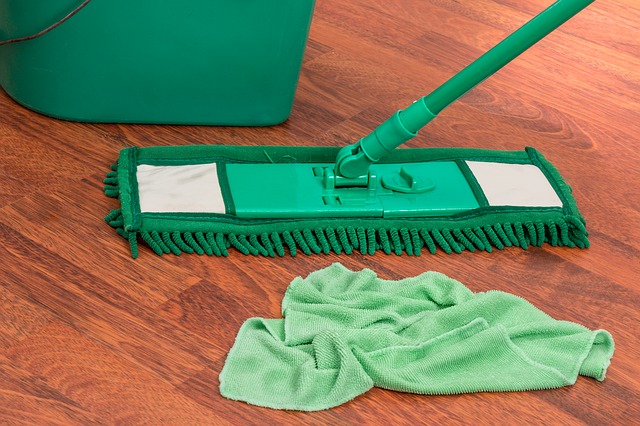How to Clean up Loose Dirt and Debris
Never use a vacuum cleaner on laminate flooring. The roller wheels on a vacuum cleaner can can damage the flooring, leaving rubber marks that are hard to remove. In addition, the brush roller on a vacuum can create small scratches, allowing dirt and debris to embed itself in the floor.
Use a soft broom to clean. A swiffer-style cleaner can be a great way to pick up dust and other debris. A swiffer-style cleaner uses an electrostatic cloth to attract dust, preventing it from spreading around a room.
Mopping with Baking Soda
Many cleaning products can leave stains on laminate floors, creating the appearance of streaks when the floor dries. In addition, some cleaning solvents can eat away the surface of a laminate floor, ruining the appearance and increasing the chance of staining. Never use any cleaning product not designed for laminate flooring.
For tough stains, a 5-1 mixture of baking soda can provide powerful cleaning. Mix 1 part baking soda to 5 parts warm water, and stir. Apply the mixture directly to the stained area, and allow to the solution to sit for 10 minutes. Using a rag, wipe up the baking soda mixture. The stain should be lifted out of the floor, leaving a clean surface underneath. It may be necessary to rinse the area with water afterwards, as baking soda can leave a fine residue on the floor.
Mopping with Vinegar
Vinegar can be a safe and effective way to remove many stains on a laminate floor. Mix 1 part distilled vinegar to 2 parts water. Using a soft-headed mop, clean the floor in a circular pattern. Make sure to use distilled vinegar without any odor — vinegar can impart a sour smell in a room.
Cleaning with Ammonia-Based Solutions
For tough stains, an ammonia-based cleaner can be effective on many types of laminate flooring. Ammonia is a common ingredient in many window cleaner solutions. Ammonia is effective at preventing streaking on windows; it’s also effective at preventing streaking on floors.
Before using any ammonia-based cleaning solution, test the agent in a small area of flooring. It’s best to use flooring that isn’t visible, as some cleaning agents can damage the floor. If the ammonia-based cleaning solution is effective at cleaning a small area, it’s usually safe to use on a large section of flooring.
Mix 1 part window cleaner to 1 part water, and add to a mop bucket. Clean the flooring using a soft-headed mop, and allow to dry. Ammonia may have a strong smell, so it’s important to provide ventilation in an area where ammonia is being used. Never mix any ammonia product with bleach, as it can create a dangerous gas.

